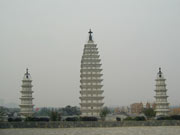| The Three Towers in Dali
 The three towers in Dali are also known as the three towers of Chongsheng (esteem holiness) Temple or Dali's towers of Chongsheng Temple. In front of the highest apex of the Blue Mountain - where Chongsheng Temple used to stand in the northwest of the ancient Dali city-there stands the main tower and the other two towers: one to the north and one to the south. The three towers in Dali are also known as the three towers of Chongsheng (esteem holiness) Temple or Dali's towers of Chongsheng Temple. In front of the highest apex of the Blue Mountain - where Chongsheng Temple used to stand in the northwest of the ancient Dali city-there stands the main tower and the other two towers: one to the north and one to the south.
The main tower is larger. It stands in the east part of the temple. Built in the Nanzhao (an ancient kingdom in Tang dynasty) period of Tang Dynasty, it is also called Qianxun tower, and its formal name is Fajietonglingmingdaochengta (a tower which leads to the understanding of Buddhism.) The tower is square outside and hollow inside, and each floor of it is bigger than the one above. Made of square bricks, the tower has dense eaves. It has altogether 16 floors and is 69.13 meters tall. In every floor, there are two niches opposite to each other for holding figures of Buddhist gods, and two windows for aeration and lighting. The Sha (the top of a Buddhist tower) of the tower consists of a newel, a baoding (the top point), a baogai (the cover), a Xianglun (a Buddhist wheel-like thing), a lotus-flower seat. If you get to the top of the tower and overlook the whole ancient Dali city, everything is presented to your eyes. Before your eyes is a majestic picture-the silvery Blue Mountain, the jade Erhai Lake and everything else. It is like a painting of dazzling beauty. The tower base, which is 1.1 meters tall, has two layers: the lower one is rounded with marble railing and columns; the upper one is laid up with bricks and is 2.07 meters tall. The main body of the tower is a structure rounded with thick walls. Each side of the main body has a width from 9.81 meters to 9.85 meters. The walls are about 3.3 meters thick. The sides within the tower are vertical and the upper part is connected with the lower part. There are wooden stairs in the shape of " ",by which one could get to the top. On the bricks, there are many engraved Sanskrit and Chinese characters. In each niche and the top, numerous cultural relics like figures of Buddhist gods and written volumes of Sanskrit, Tibetan, and Chinese scripts are stored. ",by which one could get to the top. On the bricks, there are many engraved Sanskrit and Chinese characters. In each niche and the top, numerous cultural relics like figures of Buddhist gods and written volumes of Sanskrit, Tibetan, and Chinese scripts are stored.
The other two towers either in the south or north are smaller in size. They were built roughly in the Wudai period (a period after the Tang Empire collapsed) or in the first stage of the Dali Kingdom in Song Dynasty. Both the two towers are 42.19 meters tall and eight-square. Each tower has ten floors. The proportion of each floor, the outline and decorations are all different from the Qianxun Tower (the main tower). The smaller towers have lower bases. And from the second tower up, every floor is of the roughly same length. The outline of the tower is like a taper, and the cross section is a round curve that looks graceful. On all the eight sides of the tower, there are niches of various shapes. On the eaves of the towers, there are Yanglian (upturned lotus) or Tuanlian (holding in a clasp lotus) sculpts as decorations. On the main body of the tower, there are many figures of Buddhist gods, lotuses and vases in relief refined and exquisite shapes, which vary from floor to floor.
In terms of architecture style and shape, the three towers are similar to the Xiaoyan (small wild goose) tower in Xi'an.
Facing the east, the three towers form a triangle. Forming a shape, which is like that of a Ding (an ancient cooking vessel with three feet), the overall layout is very unified, grand, graceful and harmonious. Instead of many earthquakes and years of wind and rain, they still stand lofty between the Blue Mountain and the Erhai Lake. As the most ancient brick-and-stone architecture in Yunnan, the three towers are very important data for the research of ancient architectures and Buddhism in China, as well as the history of the Nanzhao Kingdom and the Dali Kingdom.
Richly Ornamented Civilian Architecture <<
The Wonder of the Butterfly Spring >>
|